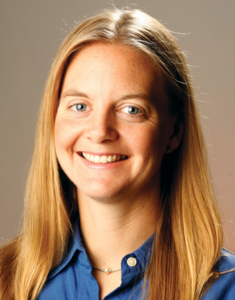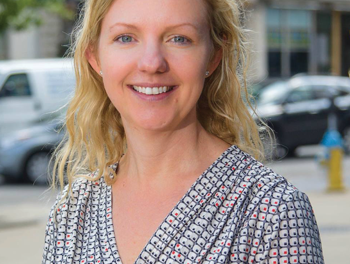Past debates about reading instruction have been heated, but there’s a lot of consensus among researchers today, especially around the idea that the science of reading is a broad body of research.
 Amanda P. Goodwin is co-editor of the academic journal Reading Research Quarterly and an associate professor of literacy at Vanderbilt University’s Peabody College of Education, Nashville, TN. She has taught in public and private schools at the elementary, middle, and collegiate levels, and she frequently works with states and school districts to strengthen their literacy plans and instruction.
Amanda P. Goodwin is co-editor of the academic journal Reading Research Quarterly and an associate professor of literacy at Vanderbilt University’s Peabody College of Education, Nashville, TN. She has taught in public and private schools at the elementary, middle, and collegiate levels, and she frequently works with states and school districts to strengthen their literacy plans and instruction.
Phi Delta Kappan: Currently, you and your Vanderbilt colleague Robert Jiménez serve as co-editors of Reading Research Quarterly (RRQ), which is one of most highly respected academic journals in K-12 education, featuring articles on reading and reading instruction, writing, oral language, and other aspects of children’s literacy development. Ordinarily, the editors of RRQ have their hands full publishing four issues a year, but you decided to publish a pair of extra issues, in 2020 and 2021, focusing specifically on the science of reading.
The science of reading has become a very hot topic in recent years, not only among researchers but also among journalists, school reformers, and policy makers, some of whom have argued that it is a specific, evidence-based way to teach children to read, that it’s the only effective way to do so, and that educators need to get with the program and stop using approaches that aren’t backed by solid research. As you’ve written, this argument is “reminiscent” of past “reading wars” (such as the struggle between phonics- and whole language-based approaches to instruction), which have often divided elementary education into opposing camps. Is that why you decided to devote a couple of special issues of RRQ to this topic? Were you hoping to show that there’s no need for another reading war?
Amanda Goodwin: Actually, our main goal was to bring more clarity to the debate. As a researcher, I spend a lot of time at academic meetings and conferences, and a number of years ago, I started hearing a lot of talk about the science of reading in those settings. I also spend a lot of time in classrooms working with teachers, and they were talking about it a lot, too. And as a parent, I was also hearing the term come up at parents’ groups. Basically, I was hearing about the science of reading everywhere I went, but, depending on the setting, people seemed to mean very different things by it. So, our main goal for these issues of RRQ was to encourage researchers to define the term in clear and consistent ways and provide updated research so that we can have a more coherent debate about what the existing evidence actually tells us about reading, reading instruction, and related topics. Basically, we wanted to provide the latest research studies to inform the debate and to figure out how to best teach reading and writing!
Given how heated the past debates in this field have been, I was expecting researchers to send us articles that take very different views on the topic. But I was surprised — and also excited — to see that there’s actually a lot of consensus, especially around the idea that the science of reading is a broad body of research. You know, the version of the science of reading that has been presented in the media is very narrow, focusing mainly on alphabetics, phonics, and word reading. It’s also pretty directive, telling teachers that if they want to help kids learn to read, then they should do this, not that. But when we invited researchers to propose and submit articles on the science of reading, that’s not how they defined it. In all, we received about 90 article submissions and published 50 of them, many written by leading experts in reading and literacy, and we did not hear calls for the sort of narrow, directive approach to reading instruction that journalists and policy advocates often promote.
When you ask the experts what they mean by the science of reading, they describe a diverse set of research studies, including many lines of research into a wide range of topics.
Actually, the researchers chose to define the science of reading in much broader terms. For instance, one well-known scholar, Steve Graham, wrote (and I quote), “The science of reading involves studying how reading operates, develops, is taught, shapes academic and cognitive growth, affects motivation and emotion, interacts with context, and impacts context in turn. It includes genetic, biological, environmental, contextual, social, political, historical, and cultural factors that influence the acquisition and use of reading.” Another, Patricia Alexander, says, “As someone who has been conducting empirical studies of reading for 40 years, I see the science of reading as contributing to a vast interdisciplinary store of critical information about reading-related skills, processes, antecedents, and outcomes, representing linguistic, cognitive, social, cultural, neurological, and psychological dimensions.”
I know, those are pretty thick, wordy definitions. But the long and the short of it is that when you ask the experts what they mean by the science of reading, they describe a diverse set of research studies, including many lines of research into a wide range of topics — not just phonemic awareness, phonics, reading fluency, vocabulary, and comprehension but also language development, motivation, dyslexia, the reading of digital texts, multilingual literacy, the literacies of Black students and other historically minoritized student groups, and on and on. I just don’t see anybody talking about a battle between science and non-science.
Some researchers probably started out thinking they were in different camps, but during the editing process, that changed. You know, in an academic journal like RRQ, we ask experts to review each article and give the authors anonymous feedback. A lot of them pushed the authors to say more about the gap between research and practice and to consider differing perspectives. And when they revised their articles, those researchers who started out in separate camps seemed to move more to the center and acknowledge and welcome other views. So, overall, I’d say that the experts agreed that it’s valuable to conduct various kinds of scientific research that aims to better understand and meet children’s complex and varied needs — not to insist that there’s a single, “one best” way to teach reading.
Kappan: Of course, this isn’t the first time researchers have tried to take stock of what the science says about reading and reading instruction. More than two decades ago, the U.S. Congress funded a massive effort, directed by a blue-ribbon National Reading Panel (NRP), to review and synthesize the existing research in this area, leading to the publication, in 2000, of the NRP’s report, Teaching Children to Read. It’s hard to overstate just how much influence that report has had, since then, on education policy, teacher education, instruction, student assessment, curriculum, classroom resources, and on and on. But two decades is a long time in education research, and it sounds like a lot has changed since 2000. How does the current science of reading expand on or differ from what was described in the NRP report?
Goodwin: The NRP report was really wonderful in a lot of ways. Given the evidence base at the time, though, the panel chose to sort the research on reading instruction into pretty broad categories: phonemic awareness, phonics, fluency, vocabulary, comprehension . . . Since then, and as you can see in the RRQ articles, we’ve learned a lot more about each of those buckets and what does or doesn’t go into them. And we’ve added some more buckets, too.
For example, the NRP report didn’t really focus on language comprehension, except to say that vocabulary knowledge is important to reading comprehension. But since then, researchers have looked much more deeply into how children learn to understand written language and use it to communicate about complex ideas.
For instance, newer research shows just how important it is to support young children’s understanding of morphology (how things like root words and suffixes work) and syntax (how words can be arranged in different ways and into different kinds of sentences). These kinds of language skills matter a lot when you start to read books that include long words and paragraphs, full of complex information and ideas. By the time you get to the 3rd or 4th grade, you might be able to decode text really well. You might even be familiar with the topic you’re reading about, and you might know a lot of the vocabulary. But if you don’t know how to make sense of the ways in which words are modified by prefixes, or how ideas are communicated via word order and sentence structure, then you’ll run into some problems. Plus, you need to understand not just what individual words mean but also their nuances. For example, you have to be able to understand whether a word has a positive or a negative connotation, depending on who’s using it and in what context. You have to be able to tell the difference between formal and informal language, or when the author’s being serious and when they’re being ironic, or when they’re giving a personal opinion and when they’re stating facts.
Our schools tend to be pretty good at teaching kids to decode written language. Most kids are successful in the early years of reading instruction, when the focus is on reading simple texts. But if we want them to be successful in the middle and upper grades, then we also need to teach them more complex language skills, even while they’re learning to decode. Basically, the NRP was right in many ways: We do need to teach phonological awareness, phonics, fluency, vocabulary, and comprehension. But today’s science of reading says so much more about how to do this — and about what else to do.
Kappan: Can you give some other examples of ways in which the current science of reading differs from what the NRP report found 22 years ago?
Goodwin: Since the NRP report, we’ve learned a lot about how diverse content knowledge (in science, social studies, art, and other areas) matters to reading comprehension. We’ve learned a lot about digital literacy, play and its role in literacy development, writing instruction (and its relationship to reading), and what’s involved in teaching reading to English learners and multilingual students. We’ve become much more aware of the many strengths that students from diverse cultural and linguistic backgrounds bring to the classroom, such as differing ways of using language, telling stories, and interpreting texts. And, just as important, we’ve become more aware of how complex and uncertain the work of reading instruction really is.
After the NRP report came out, a lot of people seemed to think that it gave researchers license to tell teachers exactly what they should do in the classroom: Here’s how you should teach letter recognition, here’s the most effective way to support reading fluency, and so on. But actually, the more researchers learn about reading, the more obvious it becomes that the relationship between research and practice doesn’t work that way. Teachers make hundreds, if not thousands, of instructional decisions each and every day. We can give them research-based principles and resources and suggestions about specific practices and approaches that tend to be effective. But when it comes down to it, teachers have to do what makes sense in the moment, given the specific context in which they work, the specific students they work with, and the constant stream of judgment calls they have to make.
I don’t want to be critical of the National Reading Panel, though. Like I said, they did great work. And if you look across the articles we just published in RRQ, you’ll see that the current science of reading confirms a lot of what the NRP found 22 years ago, including how important it is to provide systematic instruction in phonological awareness, phonics, fluency, vocabulary, and comprehension. That’s still Reading 101. But since then, researchers have filled in a lot of the gaps in those areas, explored other areas, and learned a lot more about the ways in which effective reading instruction depends on teachers’ expertise and judgment.
Kappan: As you said, though, the NRP findings have had — and continue to have — an enormous influence on education policy, curriculum, classroom practice, and so on. Researchers may have moved past Reading 101. They may understand that there’s no simple, all-purpose formula for effective reading instruction. But are state policy makers and school and district leaders getting the message?
Goodwin: Policy makers don’t necessarily want to hear that the science is more complex and less certain than we thought. It’s much easier to get public support for a handful of “proven” practices. For example, in Tennessee (where I live), there’s been a lot of concern about young kids missing out on literacy instruction during the pandemic. So, the legislature recently passed a bill that focuses on teaching foundational reading skills. And that’s great; our schools need more resources for early reading instruction. But the bill makes a point of defining “foundational reading skills” as the familiar buckets from the NRP report, especially phonemic awareness and phonics. But I have to ask: Isn’t everybody already required to teach those things? After all, they’ve been written into our curriculum for a long time. What about the lessons we’ve learned since then about how to teach these foundational skills more effectively? What about the many other skills that researchers now know to be important? For instance, what are we going to do to promote higher-level literacy skills? How will we differentiate reading instruction to meet students’ diverse needs? What can we do to better serve students who come from diverse linguistic and cultural backgrounds?
Policy makers don’t necessarily want to hear that the science is more complex and less certain than we thought. It’s much easier to get public support for a handful of “proven” practices.
Plus, even in an area that’s as well-researched as phonics, there’s still a lot we don’t know, and researchers continue to raise questions about what we thought we knew for sure. For instance, advocates often claim that “the science of reading” proves that it’s ineffective to use pictures and other contextual cues to help students figure out the words they’re trying to decode. Even some state literacy boards have become adamant that this is bad practice: No pictures! Teachers need to make students sound out the letters!
But their RRQ article, Donna Scanlon and Kimberly Anderson review 25 years of rigorous experimental studies in which kids were given systematic phonics instruction and also taught to use context cues to help them when they struggle to sound out words. And what they found was that kids tend to become more successful readers when they get both kinds of instruction, compared to those who get phonics alone. In short, they found that more resources are better. It’s self-defeating to insist on an either-or choice between phonics and context cueing, as though these practices were at war with each other. It’s much more helpful to treat them as complementary.
The other day, for instance, my daughter was reading a book about soccer, and when she came across the word “kick,” she read it as “dribble,” because she was relying on the meaning she was building and the picture she saw. Well, I’m fine with that. In that particular moment, she was enjoying the book and getting meaning out of it, so why should I make her stop? Sometimes the priority is to continue the story, right? It doesn’t mean she doesn’t know the word “kick” or that she isn’t learning to use the important skill of sounding out as her primary tool to support her reading. It just means she is using multiple tools.
Kappan: In other words, instead of doing what the recipe says to do (stop her and get her to sound out the letters), you exercised some discretion.
Goodwin: Exactly. And my fear is that when people insist that the science of reading is definitive, they seem to be suggesting that if we can force teachers to do what the research says and follow the script all the time, then our kids will all become successful readers. But real life is messy and complicated, and sometimes the worst thing we can do is to make everybody stick to the script. Teachers need to know what the science says about phonics instruction, but they also need some room for discretion and creativity and joy.
Recently, I was talking with one of the RRQ authors about a randomized control study she was conducting — you know, super-rigorous, quantitative research into the effectiveness of a specific teaching practice. And she said that in the middle of the study, she was observing a classroom, and she could see right away that this one teacher was just amazing. It was clear that this teacher loved what she was teaching, she was bringing a lot of joy and passion to the work, and she had her students totally engaged in reading. But whatever she was doing, it wasn’t the instructional strategy the research study set out to analyze. Maybe it had to do with how she motivated kids, or her choice of reading materials, or how she related to the particular group of students, or something else — I don’t know. Not everything lends itself to a randomized control study, and a lot of teachers have talents and gifts that are hard to measure. The problem is that if policy makers and school and district leaders demand that teachers stick to a narrow set of “proven” practices, then they can end up undermining great teachers like this one, forcing her to stop what she’s doing because it’s not in the script.
Teachers need to know what the science says about phonics instruction, but they also need some room for discretion and creativity and joy.
Kappan: One of the RRQ articles makes an important distinction between the science of reading and the science of teaching reading. How wide is the gap that separates reading research from what we know about classroom practice?
Goodwin: It’s pretty wide. There’s an urgent need to improve how we translate between research and practice, especially to do so in a way that empowers teachers, rather than treating them as worker bees. Teachers don’t need to be told how to teach reading. Rather, they need to be kept informed about what researchers have learned, so they can teach reading more successfully. The better they understand what the science says, and the more confident they are in their own knowledge and expertise, the more they can use it to inform their practice.
Also, the more they know about the research, the better they can advocate for curricula, textbooks, and teaching models that fit their local context, rather than being told to follow a specific recipe that was found to be effective in some other setting, So, when I say we need to get better at “translating” the research, I’m not talking about converting research findings into scripted teaching practices. Rather, I’m talking about explaining the research more clearly, so that teachers can use it to inform their professional decisions.
When you visit classrooms, you see all these curriculum materials that are labeled as “research-based.” Well, I’m a researcher, so when I see things like that, I want to know what’s their evidence? What are their citations? What studies did they conduct? Why should the school purchase these materials? What makes the publisher think this intervention is appropriate for these particular students?
It’s really important to ask these kinds of questions, rather than just accepting what the publishers tell you or what the researchers say you should do. And my argument is that teachers should be empowered to ask these questions, too. But that doesn’t mean teachers should be expected to read RRQ and attend academic conferences. It means that reading researchers need to get better at translating and disseminating findings in ways that make sense to practitioners. The burden should fall on us researchers. We need to get better at communicating with teachers, respecting their expertise, and treating them as partners.
Ultimately, the term science of reading can be interpreted in divisive ways or in informative ways. We know a lot about reading and how to teach reading (and writing!), and we should use that. Classrooms should be full of these effective, research-based practices. But there is no single way that is a magic solution. I have learned that the science of reading is most effective when it is broad, bridges perspectives, and has the goal of sharing accurate, evidence-based, and meaningful understandings that can move us forward.
This article appears in the May 2022 issue of Kappan, Vol. 103, No. 8, pp. 32-36.
ABOUT THE AUTHOR

Rafael Heller
Rafael Heller is the former editor-in-chief of Kappan magazine.










